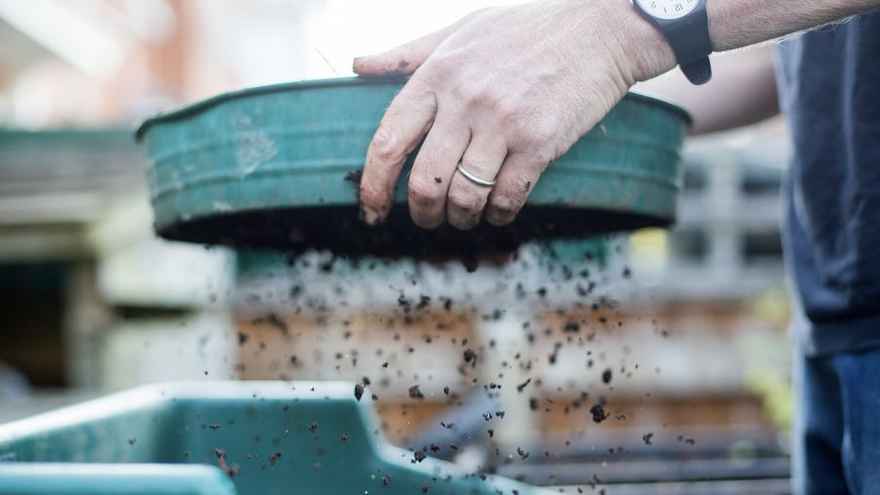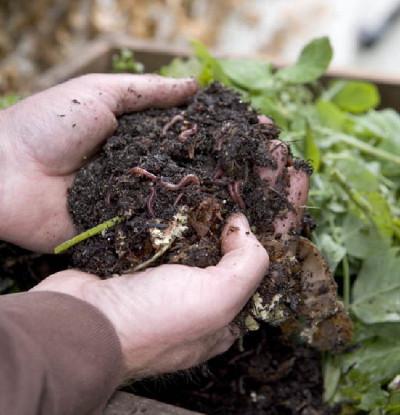How to create a living soil - and dramatically increase the productivity of your growing

Soil life: the best kept secret to successful container growing?
If you want to grow food successfully in containers, nurturing soil life can make a huge difference. Worm compost, for example, is full of microbes and life. Add it to your containers and you will get more vigorous growth, and far fewer pest and disease problems. Discovering this, was the biggest turning point in my growing (more important, even, than self watering containers), transforming sporadic successes into something more consistent.
 Worm compost is rich in microbial life as well as worms - and is invaluable for creating a living soil when growing in containers in small places
Worm compost is rich in microbial life as well as worms - and is invaluable for creating a living soil when growing in containers in small places
Why is soil life important?
Healthy organic soil in the natural world supports a web of life including bacteria, fungi, protozoa, nematodes as well as larger creatures like worms and slugs. These organisms play a vital role in the life of plants. They break down organic matter to make the nutrients available for plant roots. They condition the soil and create air spaces and tunnels in it – improving aeration and drainage. And they compete with other more harmful organisms in the soil, ones that will damage your plants if left unchecked. Soil life is complex - so the above is just my attempt to summarise some of the main benefits you can expect when you add life to your containers!
Why do you need to add life to containers?
Most commercial composts that we buy are sterilised and low in microbial life. So is municipal compost (it has to be made at hot temperatures to kill pathogens, killing much of the beneficial life, too). So if you want life in your containers – and to mimic soil in the natural world - you need to add it.
How can you add soil life to your containers?
There are several different ways you can add life to containers. There's also things you can do to support and nurture life in containers once you've got it - and I'll share these with you in a future post. Be aware that some things - like pesticides, slug pellets (even organic ones), and inorganic fertilisers - will actually kill soil life, and may work against the outcome you are trying to achieve.
1. Worm compost
Worm compost is particularly rich in soil life. It's my number one choice for adding life to containers. When matter is passed through the worms body it becomes inoculated with all sorts of tiny life forms. So worm compost contains bacteria, fungi and other microscopic goodies (as well as worms!). Unless you have a phobia of worms, I highly recommend you buy or make a wormery to recycle your waste food and make your own worm compost. They may be easier to make than you think – see www.bubblehouseworms.com, for a DIY idea - as well as some lovely wooden worm boxes (wood is my preferred choice for a wormery - again, it's easy to make your own). Add about 10 – 15 % worm compost to new compost to inoculate it with life.
 Teeming with life - the small white things are pot worms - but there are also billions of organisms in this bowl that you can't see.
Teeming with life - the small white things are pot worms - but there are also billions of organisms in this bowl that you can't see.
2. Homemade compost
Homemade compost is also rich in life. It's not quite as rich in microbes as worm compost, but still lively! Add 15 – 30% by volume to new compost to inoculate with life
3. Leaf mould
I don't know many people growing in urban spaces who have the space or access to enough leaves to make leaf mould (would love to hear from you if you are). But if you do – or have a supply – this is another ingredient teeming with life. It's a particularly useful ingredient for making seed sowing mixes as it is also low in nutrients. You'll find many recipes on line for seed compost but one is to mix about 40% leafmould, 40% multipurpose compost and 20% sand.
4. Manure
Manure is also rich in microbial life. In urban places you can often find it - free or at low cost - at City Farms or police stables. Manure varies tremendously in quality and the goodies - and nasties like drug residues - that it contains – so ask around and try in small quantities first. Add about 10 – 30 % of well rotted manure to new compost to inoculate it with life. Either put it into the bottom of the pot or mix it in thoroughly.
5. Bokashi
Bokashi is Japanese method of composting food quickly in a tightly sealed bucket. Benefits of bokashi are that you can add almost any food (even meat), it works quickly, can be done in a very small space, and doesn't smell (much). The drawbacks are that you need to buy bokashi bran for it to work, and the pickled product is not as versatile as worm compost. But you can add it to the bottom of containers to add both organic matter and microorganisms. Mix about 10 - 20% into the compost in the bottom third of a container.
6. Mycorrhizal Fungi
Mycorrhizal fungi form partnerships with plant roots and, in basic terms, help the plant extract more nutrients from the soil. They are now available to gardeners in several different forms - I'm trying some that come mixed in with chicken manure pellets. I can't say much about them yet from personal experience (watch this space!). But from what I've read, it's worth experimenting. If you've tried any, I'd love to learn from your experience. These are six ways you can introduce soil life to containers - do you have a preferred option? Or know of another way not mentioned here?

32 comments
Leaf mould - very helpful when dealing with clay
When I was still living in London, I got leaves from the estate management, after they swept the leaves up. For them it was waste and they were rather puzzled, why I should want them. I never really kept if for very long, but it made good mulch already by spring, only half rotted. Containers with a water reservoir (aka 'self-watering containers'), compost and mulch are the key hardware for container gardening to my mind.
I have a proper compost bin now, but when having less space, I fared well with two pop-up bags and large saucers for lids. One pop-up bag got filled with garden waste and used earth (where else to go with it?), the other was maturing. When it was time to swap, I sieved the compost, used what earth I got for whichever project and the rough bits, which were left, got added in when starting anew or used at the bottom as a starter. When there is no way to drain excess liquid, it is useful to add upturned flower pots and twigs at the bottom to allow for "drainage". Else you end up with a thick layer of sludge, which probably is very fertile but wrong consistency and smelly. This is even more important, if you compost kitchen waste.
Leave a comment